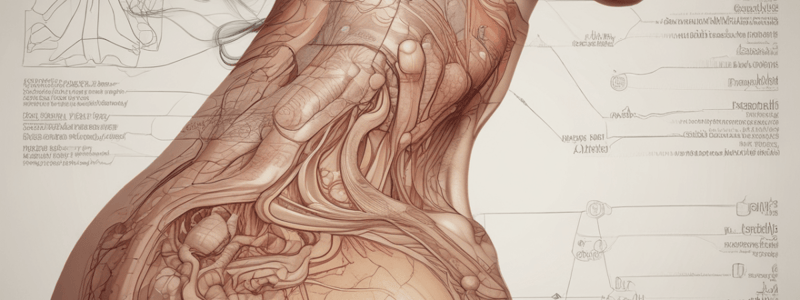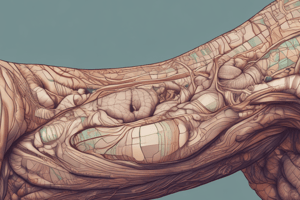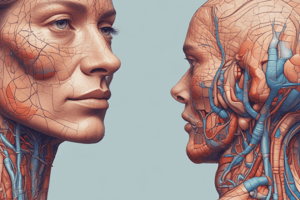Podcast
Questions and Answers
Match the following skin conditions with their primary causes:
Match the following skin conditions with their primary causes:
Tinea = Fungal infection Irritant contact dermatitis = Contact with irritant Allergic contact dermatitis = Immune response to allergen Microsporum canis = Contact with animal
Match the following skin conditions with their primary symptoms:
Match the following skin conditions with their primary symptoms:
Tinea = Scaly plaque with erythema Irritant contact dermatitis = Hyperemia, itching, skin lesions Allergic contact dermatitis = Weeping vesicles, hives, itching Microsporum canis = Crust, papules, vesicles, and bullae
Match the following diagnostic methods with the corresponding skin condition:
Match the following diagnostic methods with the corresponding skin condition:
Skin scrapings, fungal culture, polymerase chain reaction assay = Tinea Full examination and history, 'Use' test = Contact dermatitis Skin biopsy = Allergic contact dermatitis Wood light examination = Microsporum canis
Match the following treatment methods with the corresponding skin condition:
Match the following treatment methods with the corresponding skin condition:
Match the following skin conditions with their corresponding percentages:
Match the following skin conditions with their corresponding percentages:
Match the following skin infections with their characteristics:
Match the following skin infections with their characteristics:
Match the following skin infections with their diagnosed symptoms:
Match the following skin infections with their diagnosed symptoms:
Match the following treatment options with the corresponding skin infection:
Match the following treatment options with the corresponding skin infection:
Match the following prevention methods with the corresponding skin infection:
Match the following prevention methods with the corresponding skin infection:
Match the following diagnosis methods with the corresponding skin infection:
Match the following diagnosis methods with the corresponding skin infection:
Match the following types of impetigo with their characteristics:
Match the following types of impetigo with their characteristics:
Match the skin layers with their characteristics:
Match the skin layers with their characteristics:
Match the types of wound healing with their descriptions:
Match the types of wound healing with their descriptions:
Match the pressure injuries with their clinical manifestations:
Match the pressure injuries with their clinical manifestations:
Match the nutritional factors with their effects on wound healing:
Match the nutritional factors with their effects on wound healing:
Match the acute skin disorders with their characteristics:
Match the acute skin disorders with their characteristics:
Match the high-risk groups with the corresponding acute skin disorder:
Match the high-risk groups with the corresponding acute skin disorder:
Match the following skin conditions with their primary characteristics:
Match the following skin conditions with their primary characteristics:
Match the following skin conditions with their possible causes:
Match the following skin conditions with their possible causes:
Match the following skin conditions with their common treatments:
Match the following skin conditions with their common treatments:
Match the following skin conditions with their common diagnostic methods:
Match the following skin conditions with their common diagnostic methods:
Match the following skin conditions with their symptoms affecting other bodily systems:
Match the following skin conditions with their symptoms affecting other bodily systems:
Match the following skin conditions with their potential outcomes:
Match the following skin conditions with their potential outcomes:
Match the following skin conditions with their typical locations:
Match the following skin conditions with their typical locations:
Match the following skin conditions with their characteristic colors:
Match the following skin conditions with their characteristic colors:
Match the following skin conditions with their treatment options:
Match the following skin conditions with their treatment options:
Match the following skin conditions with their characteristic appearance:
Match the following skin conditions with their characteristic appearance:
Match the following skin conditions with their associated factors:
Match the following skin conditions with their associated factors:
Match the following skin conditions with their diagnostic methods:
Match the following skin conditions with their diagnostic methods:
Match the following skin conditions with their prognosis:
Match the following skin conditions with their prognosis:
Match the following skin conditions with their potential complications:
Match the following skin conditions with their potential complications:
Match the following skin conditions with their risk factors:
Match the following skin conditions with their risk factors:
Match the following skin conditions with their prevention methods:
Match the following skin conditions with their prevention methods:
The epidermis is the thicker layer of skin that contains blood vessels and skin appendages.
The epidermis is the thicker layer of skin that contains blood vessels and skin appendages.
Primary intention wound healing involves the formation of a large amount of granulation tissue.
Primary intention wound healing involves the formation of a large amount of granulation tissue.
Malnutrition can lead to impaired immune and inflammatory responses during wound healing.
Malnutrition can lead to impaired immune and inflammatory responses during wound healing.
Cellulitis is a life-threatening inflammatory disorder that affects the dermis and epidermis.
Cellulitis is a life-threatening inflammatory disorder that affects the dermis and epidermis.
Tertiary intention wound healing involves the combination of primary and secondary intention wound healing.
Tertiary intention wound healing involves the combination of primary and secondary intention wound healing.
The papillary layer is the thicker and deeper layer of the dermis.
The papillary layer is the thicker and deeper layer of the dermis.
Furuncles are typically caused by Candida albicans.
Furuncles are typically caused by Candida albicans.
Folliculitis can be caused by autoimmune diseases.
Folliculitis can be caused by autoimmune diseases.
Candidiasis typically affects the skin and mucous membranes of otherwise healthy individuals.
Candidiasis typically affects the skin and mucous membranes of otherwise healthy individuals.
Carbuncles are a cluster of infected hair follicles.
Carbuncles are a cluster of infected hair follicles.
Furuncles are characterized by a soft, red, and painful area.
Furuncles are characterized by a soft, red, and painful area.
Treatment of folliculitis depends on the signs and symptoms of the condition.
Treatment of folliculitis depends on the signs and symptoms of the condition.
Seborrheic dermatitis is a type of skin inflammation that is primarily caused by bacterial infections.
Seborrheic dermatitis is a type of skin inflammation that is primarily caused by bacterial infections.
Exfoliative dermatitis is a chronic skin disorder that has a specific known cause.
Exfoliative dermatitis is a chronic skin disorder that has a specific known cause.
Seborrheic dermatitis typically appears as erythematous and scaly patches on the skin.
Seborrheic dermatitis typically appears as erythematous and scaly patches on the skin.
Ketoconazole creams are a common treatment option for exfoliative dermatitis.
Ketoconazole creams are a common treatment option for exfoliative dermatitis.
Urticaria is a type of skin infection characterized by welts on the skin that often itch.
Urticaria is a type of skin infection characterized by welts on the skin that often itch.
Acute urticaria is less common than chronic urticaria.
Acute urticaria is less common than chronic urticaria.
Tonsurans Microsporum canis causes irritant contact dermatitis.
Tonsurans Microsporum canis causes irritant contact dermatitis.
Allergic contact dermatitis accounts for 80% of all cases of contact dermatitis.
Allergic contact dermatitis accounts for 80% of all cases of contact dermatitis.
A skin biopsy can be used to diagnose tinea.
A skin biopsy can be used to diagnose tinea.
Witch hazel cream can be used to treat irritant contact dermatitis.
Witch hazel cream can be used to treat irritant contact dermatitis.
Tinea is caused by contact with an allergen.
Tinea is caused by contact with an allergen.
Female bees can sting multiple times.
Female bees can sting multiple times.
Tick bites can cause Lyme disease.
Tick bites can cause Lyme disease.
Pediculosis is an infestation of parts of the body or clothing with lice eggs, larvae, and adults of lice.
Pediculosis is an infestation of parts of the body or clothing with lice eggs, larvae, and adults of lice.
Bedbug bites are highly contagious and can cause diseases.
Bedbug bites are highly contagious and can cause diseases.
Acne vulgaris is caused by obstruction of hair follicles and sebaceous glands due to inflammation.
Acne vulgaris is caused by obstruction of hair follicles and sebaceous glands due to inflammation.
Rosacea is characterized by a chronic red rash involving the central part of the face.
Rosacea is characterized by a chronic red rash involving the central part of the face.
Scabies is caused by a mite that burrows into the skin and lays eggs.
Scabies is caused by a mite that burrows into the skin and lays eggs.
Pediculicides are used to treat scabies.
Pediculicides are used to treat scabies.
Tick bites can cause anaphylactic reactions.
Tick bites can cause anaphylactic reactions.
Bedbug bites are often asymptomatic.
Bedbug bites are often asymptomatic.
Flashcards are hidden until you start studying




